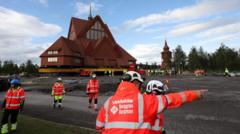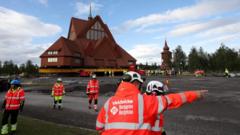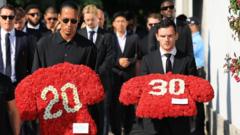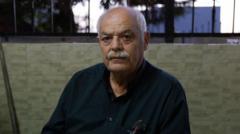In a symbolic and emotional journey, the Kiruna Church is being transported to the new city center, reflecting the community's resilience and adaptation in the face of change.
**Historic Church Relocation Defines New Beginnings in Kiruna**

**Historic Church Relocation Defines New Beginnings in Kiruna**
A landmark 113-year-old church is on the move as Kiruna faces a challenging future due to mining subsidence.
The historic Kiruna Church, a striking red timber structure built in 1912, is in the midst of a monumental relocation project, traveling 5 kilometers (3 miles) to a new location in Sweden’s far north. This extraordinary endeavor is necessitated by the risks posed by ground subsidence resulting from over a century of iron ore mining in the area. Scheduled to take two days and moving at a maximum speed of 500 meters per hour, the transfer of the church signifies a much more extensive relocation of Kiruna's infrastructure, as the entire city is being moved to safer ground.
Project manager Stefan Holmblad Johansson leads the operation. With years of planning behind them, he assures that while the challenge of moving such a significant structure is monumental, “everything is under control.” Sofia Lagerlöf Määttä, a cultural strategist from the city, encapsulated the sentiment of many locals, saying, “It’s like finally, let’s get it done. We’ve been waiting for so many years.”
Previously, other notable buildings in Kiruna, such as the three old wooden houses of Hjalmar Lundbohmsgården and the town's historic clock tower, have been moved to preserve the city’s heritage. Robert Ylitalo, CEO of Kiruna's development company, articulated the motivations behind this large-scale shift: “There’s no risk of people falling through cracks, but fissures could damage vital infrastructure like water and electricity.”
A major player in this undertaking is LKAB, the mining company responsible for Kiruna’s transformation, covering the estimated $1 billion bill for the city's extensive relocation. The church itself stands at 35 meters (115 feet) tall, weighing 672 tonnes and acclaimed as one of Sweden’s most beautiful pre-1950 buildings.
To facilitate the move, roadways have been widened, and obstacles like lampposts and traffic lights removed along the route. The church’s ornate fixtures and sacred artworks, including a significant altar painting, were protected through careful reinforcement and stabilization, ensuring their preservation amidst the physical relocation.
Beyond the engineering feat, the project's emotional significance resonates deeply within the local community. The church has been a pillar of spiritual and social activity, evoking personal memories and connections. Vicar Lena Tjärnberg expressed mixed emotions about the change, stating, "The church is leaving a place where it truly belongs... I’m grateful that we’re moving the church with us to the new city center but there is also sorrow in seeing it leave."
As the church inches toward its new home, local citizens, including Sweden's King Carl Gustaf, will witness this momentous occasion—an embodiment of Kiruna's commitment to preserving its history while adapting to new challenges. In what is being dubbed "slow TV," the entire journey is being broadcast live, highlighting a pivotal moment where history is not merely preserved, but actively continued.
Project manager Stefan Holmblad Johansson leads the operation. With years of planning behind them, he assures that while the challenge of moving such a significant structure is monumental, “everything is under control.” Sofia Lagerlöf Määttä, a cultural strategist from the city, encapsulated the sentiment of many locals, saying, “It’s like finally, let’s get it done. We’ve been waiting for so many years.”
Previously, other notable buildings in Kiruna, such as the three old wooden houses of Hjalmar Lundbohmsgården and the town's historic clock tower, have been moved to preserve the city’s heritage. Robert Ylitalo, CEO of Kiruna's development company, articulated the motivations behind this large-scale shift: “There’s no risk of people falling through cracks, but fissures could damage vital infrastructure like water and electricity.”
A major player in this undertaking is LKAB, the mining company responsible for Kiruna’s transformation, covering the estimated $1 billion bill for the city's extensive relocation. The church itself stands at 35 meters (115 feet) tall, weighing 672 tonnes and acclaimed as one of Sweden’s most beautiful pre-1950 buildings.
To facilitate the move, roadways have been widened, and obstacles like lampposts and traffic lights removed along the route. The church’s ornate fixtures and sacred artworks, including a significant altar painting, were protected through careful reinforcement and stabilization, ensuring their preservation amidst the physical relocation.
Beyond the engineering feat, the project's emotional significance resonates deeply within the local community. The church has been a pillar of spiritual and social activity, evoking personal memories and connections. Vicar Lena Tjärnberg expressed mixed emotions about the change, stating, "The church is leaving a place where it truly belongs... I’m grateful that we’re moving the church with us to the new city center but there is also sorrow in seeing it leave."
As the church inches toward its new home, local citizens, including Sweden's King Carl Gustaf, will witness this momentous occasion—an embodiment of Kiruna's commitment to preserving its history while adapting to new challenges. In what is being dubbed "slow TV," the entire journey is being broadcast live, highlighting a pivotal moment where history is not merely preserved, but actively continued.




















